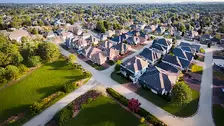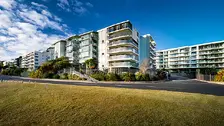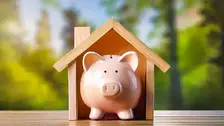Financial Freedom Through Property: How Long Does It Really Take?
 By
Trent Bradley
·
13 minute read
By
Trent Bradley
·
13 minute read

"Achieve financial freedom through property investment!" The promise appears everywhere – in seminar advertisements, social media posts, and success stories shared among aspiring investors. It's an appealing vision: passive income exceeding your living expenses, employment becoming optional, and time freedom to pursue what truly matters to you.
Table of Contents
- Defining Financial Freedom
- The Mathematics of Property Investment Returns
- Realistic Timeframes: Different Starting Points
- Factors That Accelerate Timelines
- Factors That Extend Timelines
- The Cash Flow Versus Equity Debate
- The Reality of "Semi-Financial Freedom"
- Is There a Faster Way?
- The Luminate Financial Group Perspective
- Frequently Asked Questions
Key Takeaways
- Financial freedom through property investment realistically takes 20-30 years for most investors starting from typical positions (age 25-30 with first deposit), requiring patient execution through multiple market cycles rather than expecting shortcuts or accelerated timelines
- Early career investors (age 25-30) starting with $50,000 deposit and $70,000 income can realistically build portfolios of 5-6 properties generating $80,000-$100,000 annual passive income by age 50-60 through purchasing properties every 3-5 years and allowing debt reduction over time
- Established professionals (age 35-40) with $150,000 equity and $100,000+ income can compress timelines to 20-25 years by leveraging higher income capacity to absorb negative cash flow across larger portfolios and using existing equity for faster acquisition
- Property investment mathematics combines 5-7% average annual capital appreciation with 1-3% net rental yields after expenses, creating initial negative cash flow of $8,000-$15,000 annually per property that gradually converts to positive cash flow as rents increase and mortgages reduce over 15-20 years
- Semi-financial freedom milestones appear earlier—passive income covering 50% of living expenses after 12-15 years enables reduced working hours, while covering essential expenses after 15-18 years provides security before achieving complete financial independence
- Factors accelerating timelines include consistently selecting properties delivering 7-8% appreciation versus 5% average, significantly above-average income ($200,000+) enabling absorption of larger negative cash flow, strategic debt reduction directing surplus income toward properties approaching positive cash flow, and superior property selection skills identifying undervalued opportunities
But how long does it actually take to achieve financial freedom through property investment in New Zealand? At Luminate Financial Group, we're asked this question constantly by clients beginning their investment journeys. They want the truth, not the marketing hype that promises unrealistic timelines or glosses over the real challenges and timeframes involved.
The honest answer? It depends significantly on your starting point, resources, strategy, market conditions, and definition of financial freedom. However, we can establish realistic timeframes based on typical scenarios, historical market performance, and the experiences of investors who have successfully reached financial independence through New Zealand property.
Let's explore what financial freedom through property actually means, how long it realistically takes to achieve, and what factors influence these timelines.
Defining Financial Freedom
Before discussing timeframes, we need to define what financial freedom means. The term means different things to different people, and your definition dramatically affects the timeline required to achieve it.
The Range of Definitions
At its most basic level, financial freedom might mean having passive income that covers essential living expenses – housing, food, utilities, transport, and basic necessities. For someone with modest lifestyle requirements, this might be $40,000 to $50,000 annually in New Zealand.
A more comfortable definition includes discretionary spending – holidays, entertainment, hobbies, and lifestyle choices beyond mere survival. This might require $70,000 to $100,000 annually depending on your lifestyle preferences and location.
Some define financial freedom as maintaining their current standard of living entirely through passive income, whatever that amount may be. High earners accustomed to $150,000+ annual incomes need substantially more passive income to consider themselves financially free than someone living comfortably on $60,000.
The most expansive definition includes not just covering living expenses but having surplus for continued wealth building, unexpected expenses, and providing for others. This might require passive income exceeding expenses by 30-50% or more.
For this discussion, we'll primarily focus on financial freedom defined as passive income sufficient to cover comfortable living expenses – approximately $60,000 to $80,000 annually for a single person or $80,000 to $120,000 for a couple, adjusted for regional cost of living differences.
The Mathematics of Property Investment Returns
Understanding realistic timeframes requires understanding how property investment actually generates returns and how long wealth accumulation takes given typical New Zealand market conditions.
Capital Growth Expectations
New Zealand property has historically appreciated approximately 5-7% annually over long periods, though with significant variation between periods and locations. Some years deliver double-digit growth, others see flat or declining values. Over decades, the long-term average has remained in this range.
Using conservative 5% average annual appreciation, a $500,000 property grows to approximately $650,000 in five years, $850,000 in ten years, $1.1 million in fifteen years, and $1.3 million in twenty years. This capital growth creates equity that can be leveraged for additional investments or eventually converted to income.
Rental Yield Realities
Gross rental yields in New Zealand typically range from 3-6%, with most investor properties falling in the 4-5% range. After expenses including rates, insurance, maintenance, property management, and allowing for vacancies, net yields often sit at 1-3% or even negative for high-growth but low-yield properties.
A property purchased for $500,000 generating 4.5% gross yield produces $22,500 annual rental income. After typical expenses of 30-40% of rent, net income might be $14,000 to $16,000 annually – before mortgage costs. If you borrowed $400,000 at 6% interest, annual interest alone costs $24,000, creating negative cash flow of roughly $8,000 to $10,000 annually that you must subsidize.
This negative cash flow reality in early years explains why achieving financial freedom through property takes time – you're often subsidizing investments initially, waiting for rents to increase and mortgages to reduce before positive cash flow emerges.
The Power of Leverage and Time
Property investment's wealth-building power comes from combining modest returns with substantial leverage over extended periods. While 5% appreciation on $100,000 invested directly yields $5,000, 5% appreciation on a $500,000 property purchased with that $100,000 deposit yields $25,000 – a 25% return on your invested capital.
Replicate this across multiple properties, allow time for rents to increase and mortgages to reduce, and eventually your portfolio generates substantial equity and cash flow. But this process requires patience measured in decades, not years.
Realistic Timeframes: Different Starting Points
Let's examine realistic timeframes for different investor profiles to illustrate how long financial freedom actually takes.
The Early Career Investor (Age 25-30)
Starting Position: First career job, $70,000 income, $50,000 saved for deposit, strong borrowing capacity, 35-40 years to traditional retirement
Year 1-2: Purchase first investment property ($500,000 with $100,000 deposit including costs). Property is negatively geared, requiring $8,000-$10,000 annual subsidy from personal income.
Year 3-5: Save aggressively while first property appreciates. After 5 years at 5% growth, property worth approximately $640,000 with available equity of $140,000 (after repaying some principal). Use portion of equity for second property deposit.
Year 6-10: Purchase second property using accumulated equity and additional savings. Now managing two negatively geared properties requiring combined subsidies of $12,000-$15,000 annually. Equity across portfolio growing through appreciation and principal reduction.
Year 11-15: Portfolio equity now substantial (potentially $500,000+). Purchase third and possibly fourth properties using accumulated equity. Cash flow still negative but improving as older properties' mortgages reduce and rents increase. Total passive loss perhaps $10,000-$15,000 annually across portfolio.
Year 16-20: Portfolio of four to five properties with combined equity exceeding $1.5 million. Older properties approaching neutral or positive cash flow. Begin strategic debt reduction on selected properties approaching cash flow positive status.
Year 21-25: Age approximately 46-55. Portfolio of five to six properties, several with substantially reduced debt or paid off entirely. Portfolio generates net positive cash flow of $40,000-$60,000 annually. Approaching financial independence but not quite there yet.
Year 26-30: Age approximately 51-60. Portfolio substantially mature with several properties debt-free or nearly so. Net passive income exceeds $80,000-$100,000 annually. Financial freedom achieved.
Total Timeline: 25-30 years from first investment to genuine financial freedom
This extended timeline reflects reality – starting from scratch in your twenties and building wealth gradually through consistent property investment over three decades.
The Established Professional (Age 35-40)
Starting Position: Established career, $100,000+ income, $150,000 in equity (combination of savings and home equity), strong borrowing capacity, 25-30 years to traditional retirement
Year 1-3: Leverage existing equity to purchase first investment property, possibly with reduced deposit requirements due to cross-collateralization. Strong income allows absorbing negative cash flow comfortably. After 3 years, purchase second property using continued savings and growing equity.
Year 4-8: Build portfolio to three to four properties using equity growth and strong income. Negative cash flow across portfolio is substantial but manageable given high income. Total subsidies might reach $20,000-$30,000 annually but represent acceptable percentage of income.
Year 9-15: Portfolio of four to six properties with combined equity exceeding $1.5 million. Begin strategic debt reduction on properties closest to positive cash flow. Older properties starting to generate modest positive returns while newer properties remain negatively geared. Net portfolio cash flow improving toward neutral.
Year 16-20: Age approximately 51-60. Portfolio of five to seven properties, several with significantly reduced debt. Net passive income approaching $50,000-$70,000 annually. Close to financial independence.
Year 21-25: Age approximately 56-65. Portfolio mature with substantial debt reduction. Net passive income exceeds $80,000-$100,000+ annually. Financial freedom achieved, potentially coinciding with traditional retirement age or allowing early retirement.
Total Timeline: 20-25 years from first investment to financial freedom
The established professional's higher income and larger starting capital reduces the timeline by approximately five years compared to the early career investor, but financial freedom still requires two decades of consistent execution.
The Aggressive Investor with Substantial Resources
Starting Position: Age 40-45, high income ($150,000+), substantial equity available ($300,000+), maximum borrowing capacity, aggressive investment approach
Year 1-5: Rapid portfolio acquisition using substantial equity and high income. Purchase three to four properties within first five years. Negative cash flow is substantial ($40,000-$50,000 annually) but manageable given high income. Equity growth accelerates with larger portfolio.
Year 6-10: Continue aggressive acquisition, reaching six to eight properties. Negative cash flow peaks but begins improving as older properties mature. Combined equity across portfolio potentially exceeding $2 million.
Year 11-15: Portfolio of eight to ten properties with substantial equity. Begin aggressive debt reduction strategy on selected properties. Oldest properties achieving positive cash flow while newer properties remain negatively geared. Net portfolio cash flow approaching neutral.
Year 16-20: Age approximately 56-65. Portfolio matured with several properties debt-free or nearly so. Net passive income exceeding $100,000+ annually. Financial freedom achieved.
Total Timeline: 15-20 years from first investment to financial freedom
Even with substantial resources and aggressive strategy, financial freedom requires 15-20 years. The aggressive approach reduces timeline modestly but cannot eliminate the time required for debt reduction and cash flow maturation.
Factors That Accelerate Timelines
While the examples above represent typical scenarios, certain factors can accelerate your journey to financial freedom.
Higher Than Average Capital Growth
If you consistently select properties in locations delivering 7-8% average annual appreciation rather than 5%, your equity accumulates faster, enabling more rapid portfolio expansion. However, chasing maximum growth often means accepting lower yields and greater negative cash flow.
Superior Property Selection
Investors who excel at identifying undervalued properties, negotiating favorable purchase prices, or adding value through strategic renovations can accelerate wealth building by manufacturing equity rather than relying solely on market appreciation.
Significantly Above-Average Income
High income enables absorbing substantial negative cash flow across larger portfolios, potentially accelerating portfolio acquisition pace. Income of $200,000+ allows managing negative cash flow that would be impossible on $80,000 income.
Inheritance or Windfall Capital
Receiving substantial inheritances, business sale proceeds, or other windfall capital can dramatically accelerate timelines by enabling larger deposits, faster portfolio expansion, or direct debt reduction on existing properties.
Strategic Debt Reduction
Investors who strategically direct surplus income toward debt reduction on properties approaching positive cash flow can accelerate the timeline to net positive portfolio cash flow, though this may slow portfolio expansion.
Factors That Extend Timelines
Conversely, various factors can extend your journey toward financial freedom beyond typical timeframes.
Market Corrections or Prolonged Flat Periods
Property markets don't appreciate consistently. Flat or declining periods extend timelines by slowing equity growth and potentially reducing borrowing capacity, delaying subsequent property purchases.
Excessive Negative Cash Flow
Properties selected primarily for growth potential with inadequate attention to cash flow can create unsustainable negative cash flow situations, forcing strategy pauses or even property sales that reset progress.
Lifestyle Inflation
As income increases, many people increase spending proportionally rather than directing additional income toward investment or debt reduction. This lifestyle inflation reduces capacity to fund negative cash flow or make additional investments.
Major Life Changes
Job losses, health issues, relationship changes, or other significant life events can interrupt investment strategies, force property sales, or delay portfolio expansion for years.
Poor Property Selection
Purchasing properties in locations with weak fundamentals, overpaying significantly, or selecting property types with limited appreciation potential can result in years of stagnant equity growth that halts portfolio expansion.
The Cash Flow Versus Equity Debate
An important consideration affecting timeline is whether you prioritize cash flow or equity growth.
Cash Flow Priority
Investors prioritizing cash flow select properties generating positive returns from day one, typically in regional areas with lower prices but reasonable yields. This approach accelerates the timeline to positive portfolio cash flow but may slow overall equity accumulation if these areas deliver modest capital growth.
Cash flow investors might achieve passive income of $60,000-$80,000 within 15-20 years but potentially with less total equity than growth-focused investors.
Equity Priority
Investors prioritizing equity growth select properties in major centers with strong appreciation potential but accept years of negative cash flow. This approach builds larger equity positions enabling more property acquisitions but extends the timeline to positive cash flow.
Equity investors might build $3-4 million in equity over 20-25 years but only recently achieve substantial positive cash flow as they begin debt reduction in later stages.
Balanced Approach
Most successful investors eventually adopt balanced approaches, building portfolios including both growth-oriented properties in major centers and cash-flow-positive properties in regional areas, capturing benefits of both strategies.
The Reality of "Semi-Financial Freedom"
Many investors achieve what might be called "semi-financial freedom" well before complete financial independence. This represents meaningful milestones worth acknowledging.
Semi-financial freedom might mean having passive income covering 50% of living expenses after 12-15 years, enabling reduced working hours or career changes to less lucrative but more fulfilling work. Or generating passive income covering essential expenses but not discretionary spending after 15-18 years, providing security while maintaining employment for lifestyle funding.
These semi-freedom milestones represent significant achievements that improve life quality and financial security even without complete independence from employment income.
Is There a Faster Way?
Aspiring investors naturally wonder if there are shortcuts to accelerate the journey. The honest answer is that while certain strategies can modestly accelerate timelines, there are no genuine shortcuts that don't involve either exceptional circumstances or substantially increased risk.
Renovation and value-add strategies can accelerate equity building through forced appreciation, but require significant skills, time, and capital, plus introduce execution risk. Highly leveraged aggressive expansion can compress acquisition timelines but creates substantial risk if markets correct or cash flow becomes unsustainable. Property development offers potentially superior returns but requires specialized expertise, significant capital, and involves substantially more risk than straightforward investment.
The investors who achieve financial freedom in materially shorter timeframes than outlined above typically have exceptional incomes, substantial starting capital, superior property selection skills developed over many years, favorable market timing that delivered above-average returns, or some combination of these advantages.
For most investors starting from typical positions, the timelines discussed represent realistic expectations. Trying to compress these timelines excessively often results in excessive risk-taking, poor property selection, unsustainable cash flow positions, or burnout and strategy abandonment.
The Luminate Financial Group Perspective
At Luminate Financial Group, we counsel clients to approach financial freedom through property as a long-term journey requiring patience, consistency, and realistic expectations. The typical timeline from first investment to genuine financial freedom is 20-30 years for most investors starting from typical positions.
This extended timeline isn't failure or disappointment – it's reality. Property investment builds wealth gradually through the combination of leverage, time, and consistent market participation. Investors who accept this reality and commit to long-term execution typically succeed. Those expecting unrealistic timelines often make poor decisions driven by impatience or abandon their strategies when quick results don't materialize.
The good news is that while financial freedom might be 20-25 years away, meaningful milestones appear much sooner. Your first property purchase, reaching positive cash flow on individual properties, accumulating substantial equity, achieving semi-financial freedom, and each additional property acquisition represents progress worth celebrating.
Financial freedom through property investment is achievable for many New Zealanders, but it requires accepting that wealth building is a marathon requiring decades of commitment. Start earlier, execute consistently, make sound property selections, manage cash flow carefully, and maintain long-term perspective through inevitable market fluctuations.
Twenty-five years might seem daunting when you're just beginning, but it passes regardless of whether you're building wealth or not. Investors who started 25 years ago and committed to consistent execution are enjoying financial freedom today. Those who start today and maintain commitment will enjoy that same freedom in 25 years.
The question isn't whether the timeline is longer than you hoped. The question is whether you're willing to start the journey today and commit to seeing it through. Because while property investment won't deliver financial freedom quickly, it can deliver it eventually – and for most people, eventually is far better than never.
Frequently Asked Questions
Can I achieve financial freedom through property in 10 years instead of 20-30 years?
Achieving genuine financial freedom ($80,000+ passive income) in 10 years requires exceptional circumstances rarely available to typical investors—either starting with $500,000+ equity enabling rapid portfolio acquisition, earning $250,000+ annually to absorb massive negative cash flow across large portfolios, benefiting from extraordinary market conditions delivering 10%+ annual appreciation consistently, or successfully executing high-risk strategies like intensive property development. Most investors claiming 10-year timelines either redefine financial freedom downward ($40,000-$50,000 income), start with substantial advantages (inheritance, business sale proceeds), or are describing aspirational goals rather than achieved outcomes. Focus on realistic 20-25 year timelines to avoid disappointment-driven poor decisions or strategy abandonment when quick results don't materialize.
How much passive income will one investment property generate in retirement?
A single property held 20-25 years and substantially or completely paid off typically generates $15,000-$30,000 annual net passive income after all expenses, depending on property value, remaining debt, and location. A $700,000 Auckland property with no mortgage generating 4% gross yield ($28,000 rent) might produce $18,000-$20,000 net income after rates, insurance, maintenance, and management fees. A $400,000 regional property with 5.5% gross yield ($22,000 rent) might generate $14,000-$16,000 net income. This explains why financial freedom requires portfolios of 4-7 properties rather than single properties—you need $80,000-$120,000 combined passive income to replace full-time employment, requiring multiple properties generating $15,000-$25,000 each annually.
Should I prioritize buying more properties or paying off existing ones faster?
Early in your investment journey (first 10-15 years), prioritize portfolio expansion over debt reduction—building equity across multiple appreciating properties generates more wealth than accelerating debt reduction on single properties. After 15-20 years with 4-6 properties accumulated, shift toward strategic debt reduction targeting properties closest to positive cash flow, creating income streams while maintaining equity growth on remaining properties. This staged approach captures maximum equity growth through leveraged appreciation during accumulation phase, then converts equity to income through debt reduction in later stages. Investors who focus exclusively on paying off properties before acquiring more typically build smaller portfolios generating less total passive income despite being debt-free earlier.
What if property prices don't grow for 5-10 years—does that ruin my timeline?
Extended flat periods delay portfolio expansion timelines by 5-10 years but don't fundamentally ruin long-term wealth building if you maintain holdings and continue mortgage payments. Auckland's 2017-2020 flat period tested investors' resolve, but those who held through achieved strong subsequent growth. Flat periods affect timeline by limiting equity extraction for additional deposits and potentially reducing borrowing capacity, slowing acquisition pace. However, you continue building wealth through mortgage principal reduction (forced savings) and rental income growth even when capital values stagnate. Investors who panic-sell during flat periods or abandon strategies destroy accumulated progress—those who persevere eventually benefit when growth resumes, though timelines extend beyond initial projections.
How much money do I need to be earning to realistically pursue financial freedom through property?
Minimum income requirements depend on negative cash flow capacity and borrowing serviceability rather than absolute thresholds. Single investors typically need $70,000-$80,000+ income to comfortably absorb $8,000-$12,000 annual negative cash flow on first investment property while maintaining personal financial stability. Couples with combined income of $120,000-$140,000 can manage $15,000-$20,000 combined negative cash flow across 1-2 properties. Higher incomes ($100,000-$150,000 individual, $180,000-$220,000 couples) enable faster portfolio expansion through absorbing larger negative cash flow across more properties simultaneously. Below these thresholds, focus on increasing income before investing or targeting cash-flow-positive regional properties requiring minimal subsidy despite slower capital growth.
Is property investment still worth it if it takes 25-30 years to achieve financial freedom?
Absolutely—25-30 year timelines compare favorably to alternative retirement planning approaches and deliver superior outcomes for committed investors. Traditional retirement savings (KiwiSaver, managed funds) over 30-40 years at 6-7% average returns might accumulate $800,000-$1.2 million generating $40,000-$60,000 annual income at 5% withdrawal rates. Property investment over 25-30 years can build portfolios worth $3-4 million generating $80,000-$120,000+ annual passive income through rental returns, providing both higher income and substantial capital legacy. The 25-30 year timeframe passes regardless of whether you're building wealth—investors who started in 1995-2000 are enjoying financial freedom today, while those who thought timelines were too long are still working. Start the journey today accepting realistic timelines rather than waiting for faster alternatives that don't exist.

Trent Bradley
Trent Bradley is a New Zealand financial advisor specializing in property-backed finance and investment consulting. With over 26 years of experience running his mortgage broking business, he has helped wholesale investors access high-yield property-backed loan opportunities. For the past 12 years, Trent has led Luminate Finance, a New Zealand finance company dedicated to connecting investors with secure property investment solutions.








































